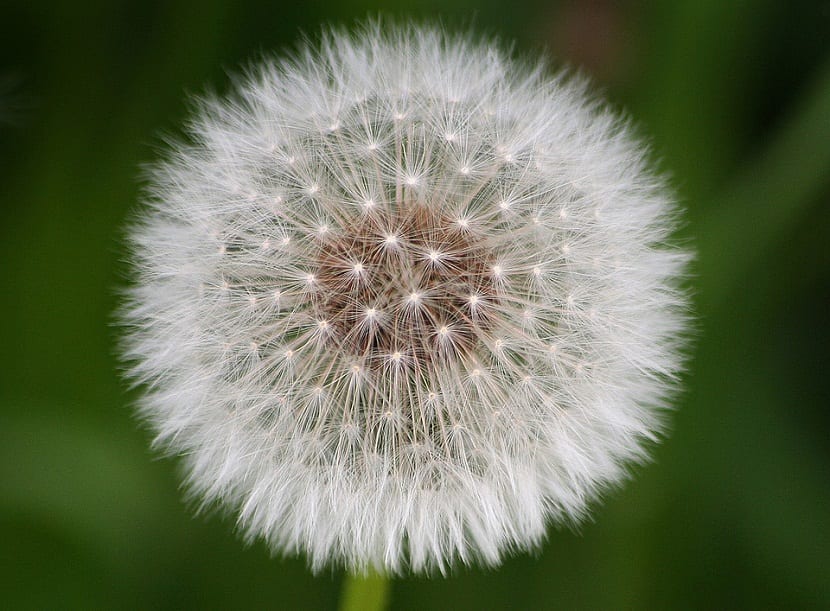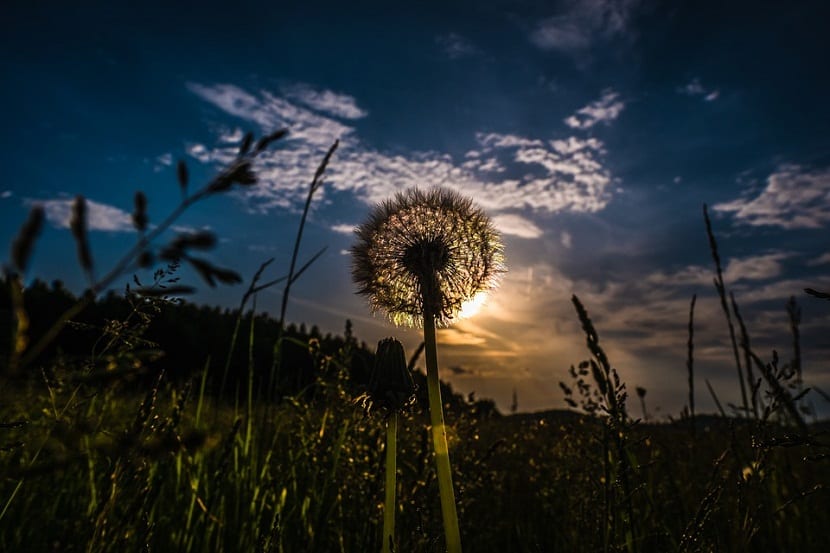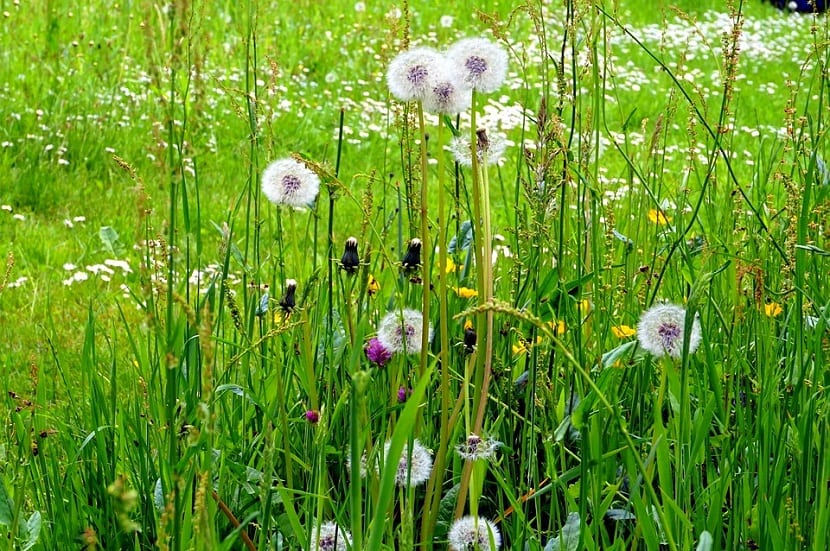
El Taraxacum officinale belongs to the Cichoriaceae (Compositae) family, although it is commonly known as Dandelion for its leaves, whose elongated and serrated shape reminds of the teeth of this great cat.
Taraxacum officinale has various other names Such as fluff, almirón, meacamas, amargón, bitter chicory, taraxacón, moraja, chipule, cerraja, buttercup and lechuguilla.
Properties of Taraxacum officinale

Taraxacum officinale it is a perennial herb with a height of up to 60 cm. It has a strong and thick root that when cut, secretes a white milk and leaves emerge from its upper end. These leaves are very varied, some have serrated edges, whole or divided into deep segments.
At the end there is a single flower, solitary, surrounded by numerous radial florets grouped in a large head. The flower has the shape of a tongue or chapter, being yellow in color and can measure up to about 6 cm, with ligule on the external florets and attached bracts.
The leaves are shaped like a basal rosette and blade gradually narrows into winged petiole, barely elliptical or spoon-shaped, with irregular pinnate lobes.
The fruit is dark brown, in the shape of a sphere about 3 to 6 mm long, feathery and unbranched.
Its habitat is where there are fertile soils and moderate moisture content. We have to say that Taraxacum officinale often is considered a weedAs it grows wild and persistent, it is found in human-influenced sites such as gardens, roadsides, meadows, meadows, crops, and vacant lots, and it grows in bright light although it can withstand shade.
Cultivation of Taraxacum officinale
The Taraxacum officinale seed is small in size, so it is convenient to start its cultivation in the nursery, in broadcast sowing or in separate lines of 10 cm., To be taken to the final place from four true leaves. Another method can be planting in double rows about 25 cm from each other, in the final fields and 50 cm apart, placing the seeds at a distance of 5 cm, the sowing season being autumn or early spring.
The main care, especially at the beginning of the crop, will be the weeding and watering. The flowering period is almost throughout the year and spring is the best season to collect the tender shoots, and then the roots are collected in early autumn.
Uses of Taraxacum officinale
The parts that are used are the roots, flowers and leaves for medicinal and food uses, since it is one of the most nutritious plants known.
The main components found in the root They are sesquiterpenes, tripterpenes, sterols, vitamins A, B, C and D, inulin and others such as caffeic acid, resin, palmitic acid, oleic, linoleic, asparagine, arginine, potassium, resins and fructose.
The leaves are high in beta-carotene, flavonoids, coumarins, potassium, and vitamins B and C. Both the leaves and the root have a bitter principle called taraxacin and that helps stimulate the appetite.
Among all the virtues offered by this plant, the following stand out:
Liver function
Stimulates liver and biliary function, presents important choleretic and cholagogue actions, which stimulate bile secretion from the gallbladder and bile ducts, prevents liver bleeding, improves purity by freeing it of toxins, which is regulated by the liver, protects the liver from degeneration caused by food or chemical poisoning, very useful in cases of hepatitis, cirrhosis and jaundice.
To prepare the infusion, boil a liter ½ of water with 100 gr of roots, drinking three cups of that infusion a day.
Diuretic properties
Thanks to the Polyphenols and the high degree of potassium it contains, it counteracts the sodium in the body and provides excellent diuretic properties They can replace body levels while other diuretics cannot. It stimulates the production of urine, that is why it was formerly called "urinary herb", also, it favors the expulsion of stones in the kidneys.
Its use is suitable in cases of fluid retention, obesity, high blood pressure and urinary insufficiency.
Digestive properties
Both the leaves and the root have a bitter principle called taraxacin that helps to stimulate appetite and stimulate digestive functions
Anemia
Due to its iron and folic acid content, collaborates in the production of blood cells, of red blood cells and in the increase of iron levels in the blood, helping the body against anemia. This plant exceeds the iron content of spinach. Spinach contains 1,5 mg of iron per 100 gr of plant, while Taraxacum officinale provides 3,10 mg.
Hemorrhoids and varicose veins
Due to the tannins, it makes it excellent painkiller and relaxing of circulation.
Constipation
Because of his fiber content constitutes a mild laxative, regulating bowel movements.
Vision
Its content of helenia and vitamin A, stimulate light collection in cases of night blindness, apart from preventing the appearance of cataracts or glaucoma. Dandelion contains 14.000 IU / 100gr of beta-carotene and 30 gr fresh covers the daily needs of an adult
Skin

It helps to heal wounds, burns and relieve bruises. The latex that contains both the root and the peduncle, is used to remove warts and blisters. It can be applied as a poultice with crushed fresh leaves. Helps fight eczema, acne, psoriasis, and herpes.
This plant stands out for its high calcium content and its recognized value for bone development and formation in your fight against osteoporosis. It has a calcium content of 187 mg per 100 g of fresh plant weight.
In Mediterranean countries salads are prepared with their most tender shoots, even also jams are made with the petals of their flowers. The adult roots, approximately 2 years old, can be roasted and ground, becoming a great substitute for caffeine-free coffee, with a delicious flavor.
It is used for the production of bioethanol and the finished product is known in the United States as Dandeleen.
The fresh leaves can be purchased in health food stores, as well as in preparations in infusions, drops, extracts, tinctures, tablets or capsules. At the time of planting
Taraxacum officinale, you can buy the seeds or collect them from the typical white fluff balls that come out in the meadows.
Contraindications
Do not use in pregnancy, lactation or allergy to plants of the Asteraceae family, like the daisy.
The European Scientific Cooperative of Phytotherapy, have recognized the benefits of this plant. Currently, studies are carried out to check if it has properties against other diseases such as cancer and diabetes, since it is registered and recognized in many official pharmacopoeias around the world.